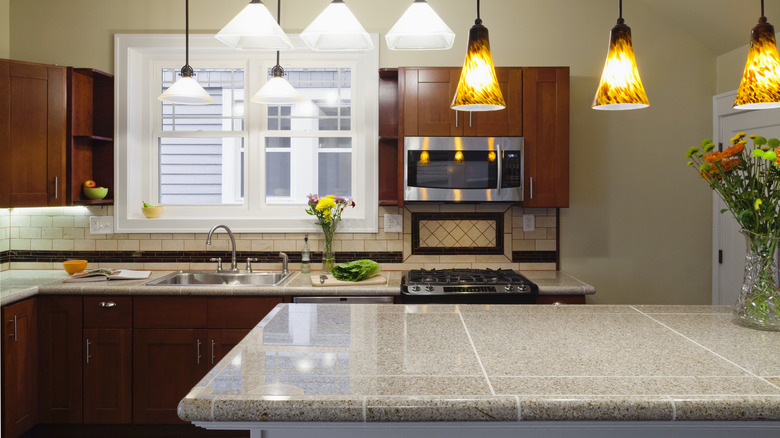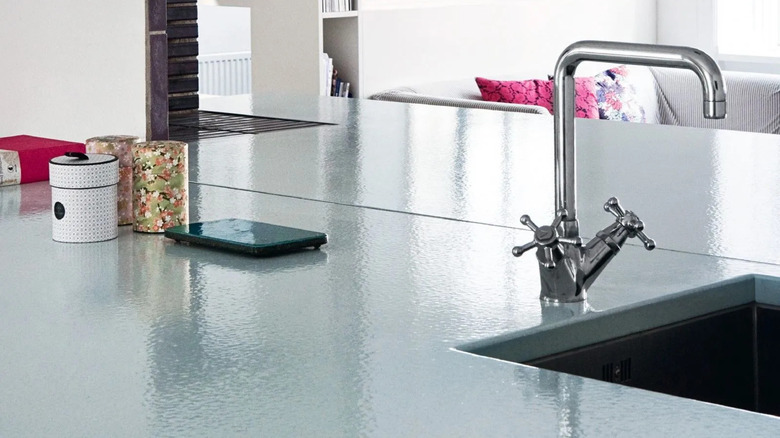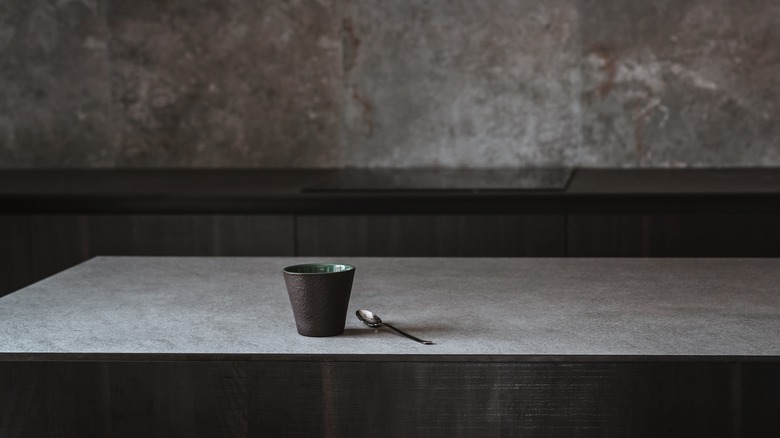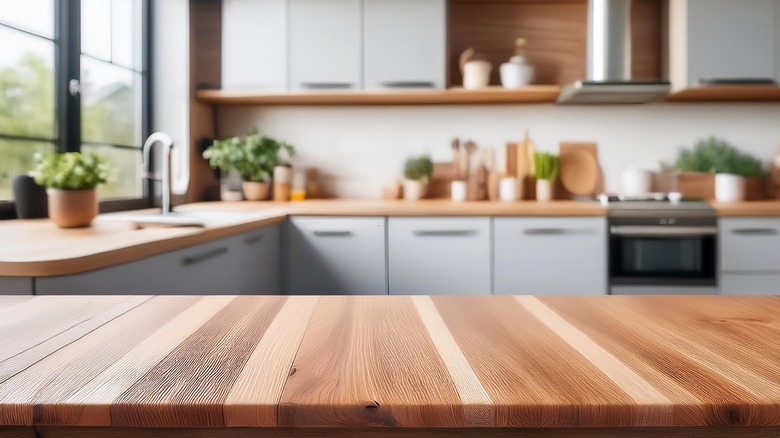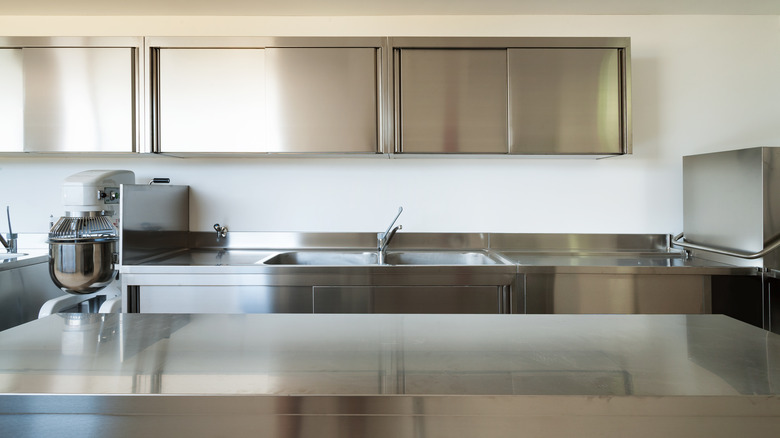Lesser-Known Countertop Materials To Consider For A Kitchen Remodel
Kitchen remodeling is an exciting project since you get to customize your home's cooking space with various design options and truly make it your own. One of the choices you'll inevitably face is what material to use for the countertops in the kitchen. The ubiquitous and popular quartz, granite, and marble counters may be the obvious options, since everyone has them. But are these run-of-the-mill countertops the ideal solution for your kitchen? Sure, quartz and granite offer fantastic durability, and marble is the go-to choice if you want your kitchen to scream luxury. But they're not the only countertop materials on the market, nor are they the only ones that last long or imbue the space with an exquisite feel.
Below, we take a look at some lesser-known kitchen countertop materials, which include porcelain and ceramic tiles, lava stone, concrete, wood, and stainless steel. Despite lacking the widespread acclaim of their quartz and granite cousins, these materials offer plenty of character and the durability you'd expect from a cooking work surface. Any of these options is bound to give your home a one-of-a-kind look and feel, and each comes with its own set of pros and cons.
Porcelain and ceramic tile countertops
Tile countertops were a thing back in the 1980s. After a decades-long lull in demand, during which their quartz and granite peers reached the pinnacle of popularity, tile countertops are coming back in style. One of the main reasons to consider fitting your counters with porcelain or ceramic is the stylish country look that's highly customizable because the tiles come in an array of designs and colors, and you can lay them in any pattern you like. Beyond appearances, tiled counters offer a few practical advantages, such as resistance to heat, water, and staining. Moreover, cleaning tiles is straightforward — if they're sealed well, then wiping them should suffice, and you can safely use most cleaning products.
Notice how we said "if they're sealed well"? Well, frequent re-sealing is the one disadvantage of tiled countertops you'll have to make peace with if you're enthralled by their country charms. If the tile countertop isn't sealed properly, or the sealant wears off, moisture and bacteria can get into the grout, which is quite porous. Also, tiled counters are never perfectly even, since each tile can sit at a slightly different level than its adjacent peers. You may find the unlevel countertop problematic for some cooking tasks that require ingredients to be evenly dispersed over the cooking surface — like when you're baking. Finally, ceramic tiles can chip easily, so you need to be mindful of the fragility when you're using the countertop.
Glazed lava stone countertops
If you want to liven up your kitchen with a splash of color without compromising on robustness, glazed lava countertops may be worth considering. Glazed lava countertops are made from lava blocks, which are cut to shape, glazed with colored enamel, then baked in a kiln. These unusual countertops can be custom-made in any color you desire, and come with a glazed surface that resists the wear and tear associated with food preparation. Depending on the baking process, the countertops can be made with a textured glazing (called "crazing"), or perfectly smooth — it's up to you. Apart from the incredible assortment of colors and the unique glazed appearance, lava stone countertops win points for being resistant to heat, stains, and acid damage, and their suitability for indoor and outdoor kitchens.
One major disadvantage of this unique material is the cost. Lava stone countertops will set you back around $300 per square foot of counter space. Why the high costs? Well, it seems that most of these countertops are manufactured by a single company, Pyrolave, which hails from France. The company dominates the market, which is extremely difficult to get into due to the regulatory constraints lava miners face. The lengthy, tedious manufacturing process also plays a role in keeping prices high. If lofty prices are not an issue, you may feel deterred from investing in a lava stone counter because its average lifespan is still undetermined. These countertops just haven't been around long enough for us to know how long they last.
Concrete countertops
When you hear "concrete countertop," you may quickly visualize a soulless, gray monolith that should serve a structural purpose somewhere out of sight instead of being an eyesore in your kitchen. But concrete countertops don't need to be gray. These days, they come in a range of colors that's only limited by your imagination. Their texture, edge profile, and shape are all incredibly customizable, and some are even made to resemble their natural stone counterparts. Concrete countertops' other benefits include a crack-resistant, long-lasting, robust composition that's made possible with fiberglass reinforcement, and a light weight, which makes installation a bit easier.
That said, concrete is a porous material that needs frequent re-sealing if you want it to remain stain-free. In a kitchen environment, where you're working with food and stains happen often, this type of maintenance is a must unless you want your investment to quickly lose its sleek appearance. We say "investment" here because concrete countertops aren't exactly cheap. If you're planning to get one, expect your kitchen remodeling budget to balloon by about $100 per square foot of counter. In other words, it'll cost as much to put in a concrete countertop as you'd pay for high-grade granite. What's more, getting a concrete countertop made to order takes some time, as designing the counter, then pouring the concrete into a mold and waiting for it to cure takes time. You'll have to get a time estimate from the supplier and factor it into your remodeling schedule.
Wooden kitchen countertops
If your kitchen remodeling project aims to inject natural elements into the space, a wooden kitchen countertop (also known as a "butcher's block") may fit well in the intended design. Wooden countertops offer a few distinct advantages you won't get with other materials. For one, these wooden surfaces are an absolute joy to behold and work on. These tops come in plenty of different aesthetic configurations, which differ with the grain alignment. A wooden countertop's rustic, country charms are augmented by their warm feel; a wooden counter will greet your hands with a pleasant warmth instead of the inorganic cold that usually emanates from a granite or quartz surface.
Despite their aesthetic benefits, there are a few unique disadvantages you should know before you buy wood countertops. Some of these are avoidable, as long as you don't mind the extra effort. For one, a wooden countertop needs to be properly sealed, then resealed several times per year. By shielding the porous wood surface with a sealant, you prevent moisture and bacteria from making its way into the fibers of the wood. On the other hand, unsealed wood can suffer from mold outbreaks and expose you to the dangers of thriving bacteria. Another issue with wooden countertops is that they can stain easily if you inadvertently place a hot item, like a pot or kettle, on them. To keep the surface free of unsightly heat stains, you'll need to use pads every time you place a scorching-hot object on the counter.
Stainless steel kitchen countertops
You may associate them with restaurants, hospitals, prisons, or other non-domestic settings, but stainless steel countertops do occasionally find their way into people's homes. And for good reason. These countertops have a lot to offer, as long as you can stomach their distinctly institutional appearance. Firstly, these countertops are completely non-porous, so there's never a chance of mold or bacteria growing on their surface. Also, you don't need to worry about staining a stainless steel countertop with food, water, or the hot pan you just picked up from the stove. For these reasons, there's no need to seal or treat stainless steel countertops — they're perfect as they are, and you can use them as soon as installation is complete. Installation is a straightforward affair, too, as is customizing the counter to your kitchen's dimensions or your desired aesthetic.
One of the main downsides of stainless steel countertops (again, if the industrial appearance doesn't bother you) is their high price. Steel countertops can command prices well north of $200 per square foot, which is what you'd expect to pay for premium granite. And that's just for the materials — you'll pay more to get the countertops installed in the kitchen. Also, much like wood, steel countertops are vulnerable to scuffs and gouges, which are impossible to repair and difficult to mask. So, if you're an accident-prone cook, stainless steel may not be the optimal material for you, and you should consider something more conventional and heavy-duty, like quartz.

